
|
Sale 58
Manuscript, Collectibles and Aerospace Auction
| Rocks/Minerals/Meteorites |
| |
| |
| Lot |
Photo |
Description |
Realized |
Lot 352 |
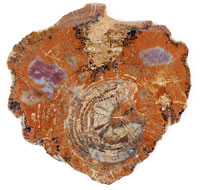 |
Polished Petrified Wood Section. This very large 16 x 16 inch agatized and polished complete section of petrified wood from the Araucarioxylon tree has a wonderful mix of colors that resulted from different minerals permeating the wood at different times from the volcanic soil over millions of years. The unusual orange color was produced by replacement by iron oxide. This exceptionally large section is one of the most colorful imaginable being predominantly burnt orange with hues of browns and shades of violet and blue. Pictures definitely do not do justice to this museum quality specimen. Araucarioxylon arizonicum is an extinct 225 million conifer tree that is the state fossil of Arizona and known to all visitors to the Painted Forest National Park.
Add $40 for domestic shipping.
Estimated Value $700 - 900.
View details and enlarged photo
| Unsold |
Lot 353 |
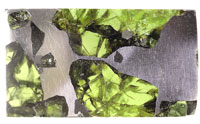 |
Esquel the Most Beautiful Pallasite. Discovered in 1951 by a farmer in Chubut, Argentina, the single 680 Kg meteorite known as Esquel has been in great demand as the most beautiful of the rare type of meteorites known as pallasites. There are three major types of meteorites, iron, stony and stony-iron. Pallasites are stony-iron meteorites that originate from the core-mantle boundary of large planetary size asteroids that were destroyed early in the formation of the solar system. This rare type of meteorite consists of iron-nickel from the core of the asteroid as well as olivine crystals known as peridot from the mantle. Peridot crystals are the only known gem stones from space found in meteorites. Esquel has the highest quality peridot crystals with a highly desirable green color. Most of the other rare pallasites have highly shocked olivine crystals that are pale or yellow in color. This 35 x 20 mm section of Esquel has been polished on both sides to get the maximum reflection of the iron-nickel matrix as well as displaying the translucent lightly shocked green peridot crystals. It weighs just over 11 grams and is displayed in a 4 x 3 inch Riker mount but could be made into an exquisite piece of jewelry if desired.
Add $15 for domestic shipping.
Estimated Value $500 - 700.
View details and enlarged photo
| Realized
$529 |
Lot 354 |
 |
Four Meteorite Sections From Four Planetary Bodies. There are only four planetary bodies in our solar system represented by meteorites, the Moon, Mars, Vesta and possibly Mercury. This unusual collection housed in a 12 x 8 inch Riker mount consists of one small meteorite section from each of these planetary bodies that can be held in hand and examined with some detail. The size of the specimens was cut to make the collection affordable as meteorites from the Moon, Mars and Mercury cost hundreds to several thousand dollars per gram. The following meteorites are represented and identified.
NWA 3141 2.2 grams Basaltic Eucrite from Vesta
Dhofar 019 .223 grams Martian Shergotite from Mars
NWA 5000 .196 grams Breccia from the Lunar Highlands
NWA 2999 .278 grams Angrite possibly from Mercury
Since no rocks have been examined from Mercury it cannot be known for certain that Angrites come from Mercury but it is known from their oxygen isotopes that they formed on a large planetary body and they contain almost no sodium which indicates that they formed in a highly refractory planet that was much closer to the Sun than Earth which leaves Mercury as the likely source since Venus has such a dense atmosphere and strong gravity.
Add $15 for domestic shipping.
Estimated Value $600 - 800.
View details and enlarged photo
| Unsold |
Lot 355 |
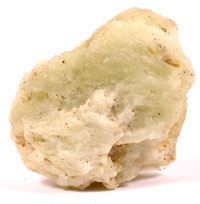 |
Libyan Desert Glass. Tektites are a mixture of earth rocks mixed with a sprinkling of meteorite material from an immense explosive event that occurred when a very large rocky meteorite vaporized before impacting the earth. The resulting mixture forms glass-like mixture. The color is usually black but it can also be green or yellow depending on the amount of silica present. This huge 830 gram 5 x 4.5 x 2 inch large specimen of Libyan Desert Glass is most unusual in having both white and green colorization but it also has a most unusual brownish-orange glass segment on one side. This probably resulted from a rare rock layer mixing with the desert sand at impact. This interesting specimen also possess the characteristic surface of small craters and voids that resulted from gasses escaping when the molten sand was solidifying in the atmosphere before being redeposited on the ground. This large almost 2 pound specimen of Libyan Desert Glass, found in the Sahara desert near the border between Libya and Egypt, is especially valuable as a small 125 gram specimen sold for over $6000 in a New York auction in October, 2007.
Add $15 for domestic shipping.
Estimated Value $500 - 750.
View details and enlarged photo
| Unsold |
Lot 356 |
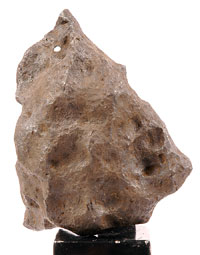 |
Meteorite - 30 Pound Campo Del Cielo With Hole. This huge 9.5 x 8 x 4 inch 30 pound iron-nickel meteorite is not only esthetically pleasing with a plethora of regmaglypts covering most of its surface but also has a small natural hole in the thinnest part of a huge 2 inch regmaglypt. Regmaglypts looking something like thumbprints form when the meteorite enters the atmosphere at a high velocity creating very high temperatures that selectively melt the pockets of Troilite (iron sulfide) much more readily than the iron-nickel matrix. These regmaglypts are what give iron-nickel meteorites their character. Because of the density of iron-nickel meteorites, holes rarely form and can only occur when a pocket of Troilite burns all the way through during melting.
Known as Campo del Cielo (field of the sky), these meteorites fell from the sky over 4000 years ago in Gran Chaco Gualamba, Argentina and were written about in 1576 by the Spanish governor who learned about them from the local Indians who believed that the iron stones fell from the sky. A large 60 ton meteorite known as Meson de Fiero (large table of iron) was sent back by ship to Spain and melted down. The best specimens of Campos such as this one are known as new Campos as they are found higher up in the mountains and have not been worn down by rusting from rain water. Esthetically sculpted meteorites with a hole are worth two to three times as much as a similar size meteorite without the rare hole and are in great demand from meteorite collectors. This important meteorite comes with a 10 inch high custom iron stand for display.
Add $30 for domestic shipping.
Estimated Value $3,000-UP.
View details and enlarged photo
| Unsold |
Lot 357 |
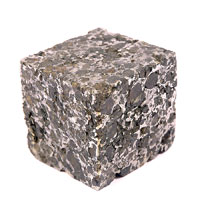 |
Meteorite Brahin Pallasite Cube. Pallasites are indeed "Gemstones" from space as they are a rare type of iron-nickel meteorite that has beautiful olivine crystals interspersed in the iron-nickel matrix and when cut and polished yield unbelievable translucent crystals of yellow/green olivine.
The first Brahin Pallasite meteorite was discovered in 1810 by farmers in the Minsk, Belorussia region of Russia. In the 200 years since then only eleven meteorites have been found from this fall totaling about 1000kgs. This large 708 gram (over 1.5 pounds) 2.13x2.13 inch polished cube makes a striking display with its iron-nickel matrix and olivine crystals ineterspersed throughout. The olivine crystals are various colors from yellow to a dark brown in the cube. This is a good opportunity to acquire a large heavy paperweight cube or just an interesting study specimen. It is unusual to be able to purchase a heavy pallasite since most pallasite sell for $10-$50 per gram.
Add $20 for domestic shipping.
Estimated Value $1,000 - 1,300.
View details and enlarged photo
| Realized
$940 |
Lot 358 |
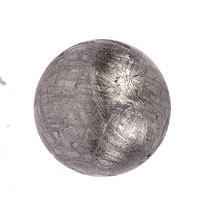 |
Meteorite Muonionalusta Sphere. Muonionalusta is an iron-nickel meteorite that was found in Norrbotten, Sweden in 1906 and since then additional meteorites have been found in one of the largest strewnfields on earth at 30 x 10 kilometers. It is the only meteorite found north of the arctic circle and fell several hundred thousand years ago and was carried by glaciers. Muonionalusta is classified as a fine octahedrite and even though its outward appearance is not attractive due to the erosion from the glacier it has one of the most beautiful Widmanstatten patterns when it is etched. Widmanstatten patterns form when the two alloys of nickel Kamacite and Taenite separate in the iron core of the large asteroid that was destroyed by collision with another large asteroid in the asteroid belt billions of years ago. This separation and pattern form only when the iron core cools at a rate of only a few degrees per million years and is not found on any iron-nickel stones on earth. This large 50mm diameter 488 gram sphere has been laboriously cut from a much larger specimen and etched to display one of the most beautiful Widmanstatten pattern found on any iron-nickel meteorite. It is very similar to the pattern found on the Gibeon meteorite which is probably from the same parent asteroid body.
Add $15 for domestic shipping.
Estimated Value $800 - 900.
View details and enlarged photo
| Realized
$705 |
Lot 359 |
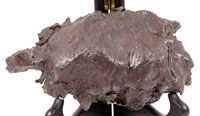 |
Meteorite Sikhote-Alin With Flow Lines. This rare extremely large 7.5 x 4.5 x 2.5 inch 7.5 pound Sikhote-Alin Iron-Nickel meteorite is a very attractive and most interesting example of a shrapnel type Sikhote-Alin meteorite. It shows many features of the huge explosion that took place on Feb. 10, 1947 high above the Sikhote-Alin mountains of Siberia. The enormous explosion tore the meteorite into thousands of smaller pieces and knocked people off their feet several miles away from the blast. The first explosion was high up in the atmosphere and the meteorites from this initial explosion exhibit regmaglypts (thumbprints) from melting for a longer time in the earth�s atmosphere. The secondary explosions occurred much closer to the ground and these meteorites show the ripping force of the explosion resulting in sharp edges and there was not enough time to form the regmaglypts. This distinctive meteorite shows signs of the explosive shearing force with sharp edges, distinctive attractive gun metal color, metal flowing over the edges and myriads of delicate entry flow lines on all sides of the meteorite. These delicate flow lines are only visible because of the freshness of this fall and flow in all kinds of directions reflecting the meteorite tumbling in the atmosphere before striking the ground. Sikhote-Alin meteorites weighing over one pound are extremely rare and in high demand.
Add $25 for domestic shipping.
Estimated Value $2,000 - 2,500.
View details and enlarged photo
| Unsold |
Lot 360 |
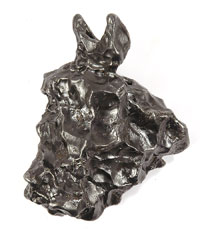 |
Meteorite Sikhote-Alin With Regmaglypts. This good sized, 3.7 x 3 x .6 inch, 426 gram (nearly one pound), Sikhote-Alin iron nickel meteorite is the rarer of the two types possessing regmaglypts, small crater-like impressions that formed by ablation of Troilite when the meteorite was streaking through the sky at high temperature. The large meteorite body broke up twice during its fall to earth with only the higher breakup creating the meteorites with the regmaglypts, the lower breakup creating the shrapnel type meteorites. The shape of this meteorite is special with various sized regmaglypts and two "horns" on top and well worth a generous premium. Having fallen on Feb. 12, 1947 in Siberia, Sikhote-Alin iron-nickel meteorites are the best preserved of all known iron-nickel meteorites. It is quite rare to find such a large esthetic specimen as the meteorite field has been well searched with only small specimens still being found.
Add $15 for domestic shipping.
Estimated Value $900 - 1,200.
View details and enlarged photo
| Realized
$852 |
Lot 361 |
 |
Meteorites, Lot of Three Different. Including a small, intact Nickel-Iron meteorite (.75x.33") from Canyon Diablo, Meteor Crater, Arizona, a small cut slice of Stone meteorite (.6x.25") from Jilin China and a small cut slice of Stoney-Iton meteorite (.25x.35") from Brahin, Minsk, Russia. Each piece is contained in a small plastic box and includes a descriptive Certificate of Authenticity from Bethany Sciences, New Haven, CT. A great introduction to meteorites and outer space.
Estimated Value $250 - 350.
View details and enlarged photo
| Unsold |
Lot 362 |
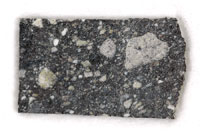 |
Moon Rock From a Lunar Meteorite. This large .6252 gram 20mm x 12mm thin section of the moon meteorite NWA 2995 is an esthetic highly detailed meteorite section from the highlands of the moon. Lunar meteorites are the most desirable and expensive of all the types of meteorites recovered and are even rarer than meteorites from Mars. A small 538 gram single pristine crusted meteorite was sound in the deserts of Algeria in December, 2005. It has been classified as a Lunar feldspathic basalt-bearing breccia which means that it is a mixture of dark basalt with off white to gray feldspathic clasts. Feldspathic clasts contain Feldspar with a high Mg/Fe ration with abundant FeO and Thorium. This particular chemistry is probably a relic of the Moon�s early crust and differs from the Moon rocks brought back in the Apollo missions which makes them very important for scientific study. These basaltic Lunar rocks were melted and partially mixed together when a large meteorite crashed into the moon millions of years ago. This rock mixture was vaporized and ejected from the moon and eventually made its way to the earth. This section is large enough to hold and examine in detail unlike most specimens that are just dust or small chips. This very valuable meteorite is housed in a plastic case and a 5.5 x 4.5 inch Riker box.
Add $15 for domestic shipping.
Estimated Value $800 - 900.
View details and enlarged photo
| Realized
$617 |
|
|